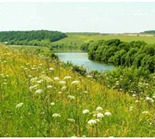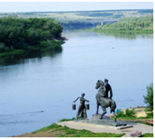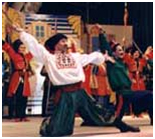Rostov region as an administrative body was founded in compliance with the Provision of the Central Committee of the USSR on September 13, 1937. The territory of Rostov Region is some 100.8 thousand square kilometers and equals to the territories of Belgium, the Netherlands and Denmark taken together.
The Region’s economic development is based on such factors as its favourable geographic position (the region brings together central Russia, the North Caucasus and Transcaucasia), abundance of natural resources, traditionally favourable conditions for development, excellent human labour resources and a well-developed transportation infrastructure.
The Rostov region is not only one of the most advanced multi-industrial and agricultural areas in the south of Russia, but also an important center of development for the sciences, education, culture and arts. The Don region is rich in deep and varied cultural traditions. Rostov, Novocherkassk, Starocherkassk, Azov, Taganrog, Tanais and other towns of Rostov region attract tourists with their rich history, wonderful nature, peaceful and friendly atmosphere, hospitable inhabitants, original cossack culture. In total Rostov region possesses 9295 cultural and historic sites under the state protection, 8066 of them are of federal significance.
Taganrog, the second largest industrial, cultural and scientific center in Rostov region, was one of the first Russian towns, constructed by a designed project. The Taganrog planning and erecting project was designed in 1699 by Peter the Great’s order. The fortress planning included apart from the military objects, administrative and cultural buildings, the Tsar Palace, courts for his noblemen, local administration, authorities, clergy, Russian and foreign seamen. The yards for soldiers, cannoniers, tradesmen, merchants and peasants were located behind the fortress walls in six settlements, protected by small fortresses, erected on the Miusskyi peninsula. By the end of the 18th – beginning of the 19th century, Taganrog was a highly developed multi-national and multi-confessional trade town and was practically the only commercial international center in the South of Russia. Since 1860th and up to now Taganrog is one of the largest Russian international ports.
It is also a home-town for the world famous writer Anton Chekhov.
Starocherkassk, a Cossack village, is a picturesque place making the visitors plunge into the history of the Don Cossacks. Established in 1570, 50 years later Cherkassk (as it was called at that times) became the capital of the Don Cossacks. It was here that the first fireworks in Russia were set off to celebrate the capture of Azov on August 18th, 1696. Starocherkassk historical and archeological open-air museum keeps the antiquities of the Cossack history. It is listed in the UNESCO touristic guide. It was established in 1970 on Mikhail Sholokhov’s initiative and consists of more than 100 civil and cultural architecture monuments and about 50000 exhibit items.
Novocherkassk, founded in 1805 as a new capital for the Don Cossacks Army Region, today is one of large towns in the South of Russia. It is peculiar not only in its glorious history, but also in remarkable features: outline, architecture, unique historical monuments. Within more than a century that was a town of the Don Cossacks elite: Cossacks atamans, military administration, army officers, officialdom, educational and cultural center.
Contemporary Azov is a cozy, small and very green town, with the industrial zone situated outside of the living area. However the town history has many interesting periods. One of them is the famous Azov siege of 1641, when the Cossacks fortress with five thousand Cossacks was being defended from the 250 thousand Turkish army for 93 days and nights. The fortress was defended and the Turkish army was crushed and driven out from the Don land. Peter the Great’s Azov campaigns of 1695-1696 were glorified by the Turkish fortress seizure and gave access to the Southern seas. The old historical part of the town still has the elements of the Azov fortress built in 18th century – the fortress walls, ditch, and the Alekseevkiy gates.






